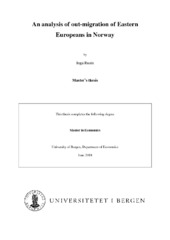An analysis of out-migration of Eastern Europeans in Norway
Master thesis
Permanent lenke
https://hdl.handle.net/1956/18773Utgivelsesdato
2018-06-22Metadata
Vis full innførselSamlinger
- Department of Economics [287]
Sammendrag
Return migration, also referred as an out-migration, is an important research topic within the labor economics. The main questions investigated within this field are concerned with the selection of the returners and the factors, affecting immigrants’ decision to leave. This thesis investigates an income effect on the probability to out-migrate. The main scope of analysis covers Eastern European immigrants in Norway. The countries of origin are divided into the regions, both inside and outside the European Union, to examine the impact of the EU factor on the immigrants’ behavior. The micro data of the immigrants’ has been provided by Norwegian center for research data (NSD). The sample contains 10% of all Eastern European population in Norway. The following questions are brought up: i) do low income earners or high income earners have a higher probability to out-migrate? ii) what are common demographic characteristics of the returners? iii) do the citizens of EU differ from the non-citizens in their out-migration behavior? The analysis is conducted on the individual level, using the linear probability model to predict the likelihood of out-migration. The empirical results of this study reveal that immigrants with the lowest income or no income at all are most likely to out-migrate, compared to middle and high income groups. The effect of income on return migration is higher in times of economic recession. The citizens of the EU countries are mostly affected by the low income. In addition, the analysis outputs indicate that growing income decreases the probability of return migration.
